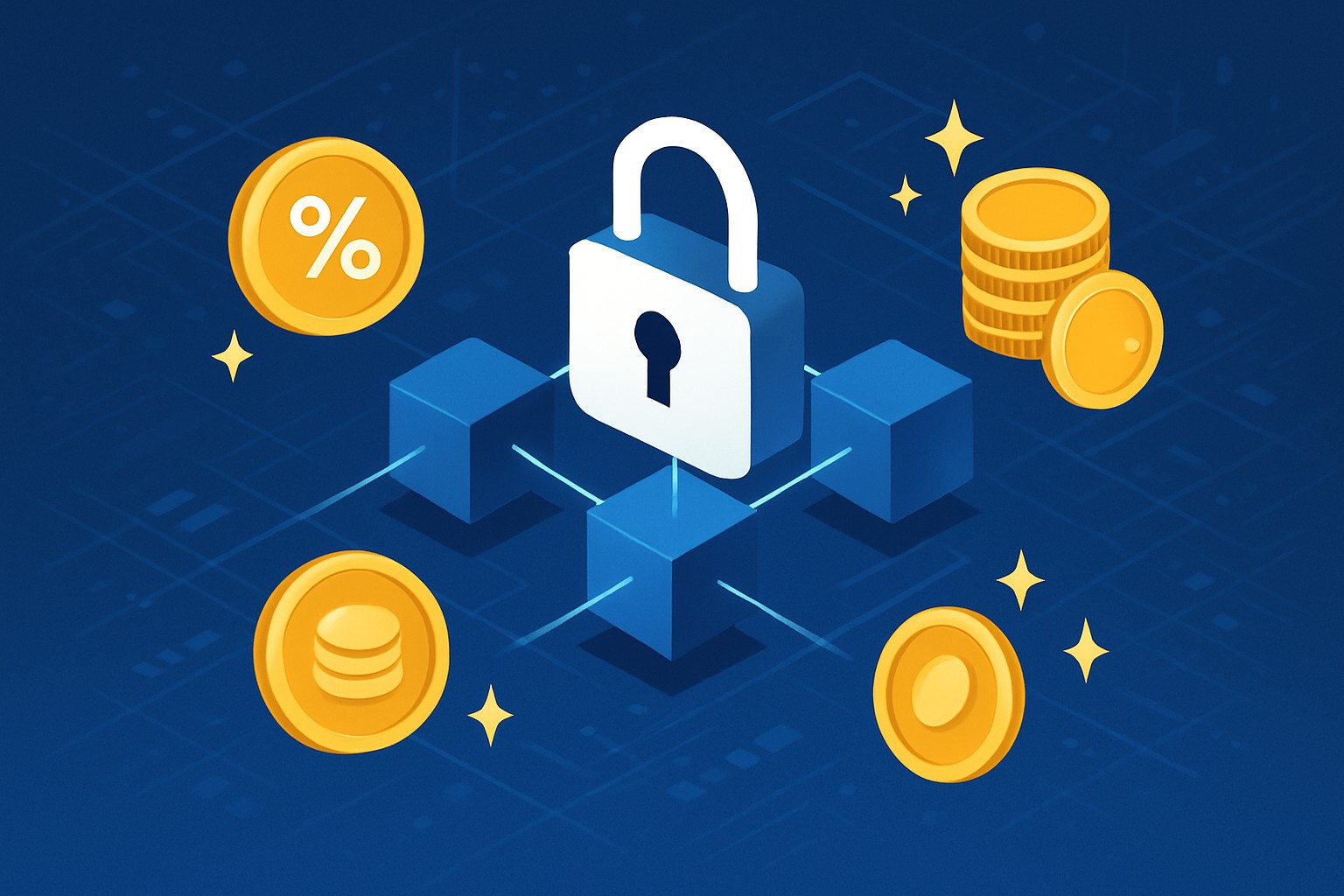Token Staking Rewards Explained and How They Work


Token staking rewards have really taken off as a popular method for cryptocurrency holders to earn a bit of passive income simply by locking away their tokens. For newcomers, the whole concept can seem pretty daunting and technical at first glance.
What Exactly Does Token Staking Mean Anyway
Token staking basically means locking up cryptocurrency tokens to help keep a blockchain network secure and running smoothly. Think of it as putting money in a savings account where your tokens are held for a set period. In return, you earn some interest or rewards—kind of like your crypto is working a side hustle for you.
- Staking means locking up your tokens so they aren’t available for a set period of time.
- These locked tokens aren’t just sitting idle because they play a important role in keeping the blockchain secure and ensuring every transaction is verified.
- Validators are the people on the network who approve new blocks by confirming they are legitimate.
- Proof-of-Stake (PoS) is a smart system that selects who can validate based on how many tokens they have staked.
- When you stake, you earn rewards as a way for the network to thank you for contributing and participating.
What Exactly Are Token Staking Rewards and How Do They Really Work?
Staking rewards stem from the behind-the-scenes hustle where validators actually create and confirm blocks. Those who stake their tokens aren’t just along for the ride—they’re the backbone keeping the network safe and sound. The system then dishes out rewards, handing them out based on how much each person pitches in.
A user locks up their tokens in a staking smart contract or protocol wallet, basically putting them on ice for a set period.
These staked tokens act as collateral, playing a important role in keeping the network secure and trustworthy.
The blockchain gets busy processing transactions and creating new blocks, picking validators based on how many tokens they’ve put on the line.
Validators then confirm transactions and add new blocks, earning their keep through block rewards or transaction fees.
The system hands out the rewards to all token stakers, divvied up according to how much each person has staked.
Staking rewards usually come in a few different forms. Some platforms like to keep things simple with fixed APY rates that give you returns which are more predictable and steady, almost like clockwork. Then there are those that offer variable yields that change based on demand or how the network is performing. This approach keeps things interesting but is a bit less certain. Inflationary rewards take a different approach by increasing the token supply to pay stakers. This can put some pressure on the token's value but often encourages more people to join in.
| Reward Type | Explanation | Example Cryptocurrencies | Typical Yield Range | Pros | Cons |
|---|---|---|---|---|---|
| Fixed APY | A fixed annual percentage yield paid to those who stake tokens — reliable and predictable. | Tezos (XTZ), Cardano (ADA) | 4% - 8% | Provides steady income, making it easier to plan your finances without second-guessing | Not very flexible when the market takes a nosedive |
| Variable Yields | Rewards that shift based on network activity and how much is staked, keeping things interesting. | Ethereum 2.0, Polkadot (DOT) | 5% - 15% | Can deliver higher returns, with rewards adjusting as conditions change, like a living ecosystem | Returns can drop off a cliff if staking interest wanes |
| Inflationary | New tokens are minted and handed out as rewards, which increases the total supply over time. | Cosmos (ATOM), Algorand (ALGO) | 6% - 20% | Great for encouraging staking by offering juicy yields that catch the eye | Comes with the risk of watering down the token's value |
Different Types of Token Staking On-Chain and Off-Chain Explained
Token staking can happen in two main ways either right there on the blockchain itself (on-chain staking) or through third-party services like exchanges or staking pools (off-chain staking). When you go the on-chain route, you’re interacting directly with smart contracts and becoming part of the blockchain consensus.
- On-chain staking is all about users locking up their tokens directly via blockchain smart contracts, which means they keep full control over their funds—no middleman in sight.
- Off-chain staking usually goes down through centralized exchanges or platforms that handle the staking for users, making life a bit easier.
- One of the biggest perks of on-chain staking is the boost in decentralization, along with a transparency that’s often clearer than day.
- Off-chain staking tends to win points for convenience and lower tech hurdles, but you’re also signing up for risks tied to custody and having to trust a third party—something to keep in mind if you value control.
Staking pools have stepped up as a handy option for smaller holders looking to join without hefty minimum stakes. By pooling their resources participants earn rewards proportional to their contribution while the pool operator handles the technical heavy lifting and spreads out the risks.
Why Do Projects Offer Rewards for Token Staking?
Blockchain projects often roll out staking rewards as a little nudge to encourage token holders to pitch in and help secure the network while keeping things nice and decentralized. By rewarding those who put their tokens on ice, these projects not only build tougher infrastructure but also foster communities that stick around for the long haul.
- Strengthening network security by encouraging more tokens to be staked and locked up, which really helps keep things locked tight.
- Managing inflation by rewarding those who roll up their sleeves and actively participate, rather than just letting tokens sit idle.
- Encouraging user loyalty, a key ingredient in keeping the token ecosystem steady and humming along smoothly.
- Promoting token holder involvement in governance, giving decentralization a genuine boost and a voice that really counts.
Staking rewards work a lot like dividends do in traditional finance. They gently nudge shareholders to stick around for the long haul by sharing a slice of the profits. Similarly, staking offers a little carrot to token holders, encouraging them to roll up their sleeves and help the blockchain ecosystem grow and thrive.
Common Misunderstandings About Token Staking Rewards Clearing Up the Confusion
Staking is gaining traction these days, but it’s still surrounded by a fair share of myths. A lot of individuals seem to think staking is a sure-fire way to make money or that the rewards show up instantly, while some even assume it comes without any risks whatsoever.
- Staking comes with its fair share of risk since token prices tend to ebb and flow, and this can definitely affect your returns.
- Rewards usually trickle in at regular intervals rather than appearing immediately after you stake, so patience is key.
- Tokens locked up in staking are often off-limits for early withdrawal without some kind of penalty.
- Depending on market conditions, staking might not always outperform simply holding onto your tokens.
- Reward rates can vary significantly between tokens or platforms, so there’s no one-size-fits-all number.
Your Quick and Friendly Guide
Getting started with staking usually goes pretty smoothly if you do a little homework upfront. First, choose a cryptocurrency that supports staking and that you genuinely feel good about holding onto for the long haul. Then, carve out some time to dig into the staking options—whether on-chain or off-chain—and take a close look at the platform’s security features and fees before you go ahead and lock in your tokens.
Dig into cryptocurrencies that offer staking rewards and fit your comfort with risk.
Choose your battleground wisely—whether that means staking directly on-chain or using a trusted exchange or pool.
Transfer your tokens to the wallet or platform ready for staking.
Lock in those tokens and be sure to follow the staking period as well as any specific rules carefully.
Keep a close eye on your rewards. When the time feels right, decide if you want to unstake or reinvest based on your goals.
Really make the most out of staking rewards by compounding through restaking the tokens you earn—letting your gains work harder for you. Also if you can, locking up your tokens for longer periods usually means better returns though it’s a bit like making a trade-off between patience and payoff.
Risks and Considerations Involved in Staking Tokens
Staking tokens might seem like a straightforward way to earn some passive income, but it’s not always a walk in the park. There are a few bumps along the road that are worth keeping an eye on before diving in headfirst. From market volatility that can make even the steadiest hands a little shaky to the ever-present risk of technical glitches or security hiccups, it’s wise to tread carefully. Plus, locking up your tokens means they’re out of reach for a while, so liquidity can be a bit of a sore spot. In my experience, understanding these risks upfront can save a lot of headaches down the line.
Staking can offer attractive perks but it’s not without pitfalls you shouldn’t overlook. The value of earned rewards can take a hit when token prices swing like a rollercoaster. Lockup periods might tie your hands when you want to access your funds. On top of that, watch out for smart contract glitches, penalties if validators slip up and shifts in reward rates.
- The value of staked tokens tends to wobble with market ups and downs, which can throw a wrench into your overall returns.
- Lockup or vesting periods often tie your hands and make it tricky to pull out funds quickly, causing liquidity headaches.
- Vulnerabilities in smart contracts might lead to losing your staked funds if someone exploits them.
- Validators face penalties called slashing for downtime or shady behavior, which can put a dent in the rewards.
- Reward rates shift over time and occasionally drop without much fanfare, so it pays to keep an eye out.
To truly safeguard your investment and maximize your token staking rewards, it’s wise to dig a little deeper into staking platforms and projects—doing your homework never hurts. Keep an eye on the network’s status and be alert to any potential hiccups along the way. I stick by this rule: never stake more than you’d be okay waving goodbye to.






